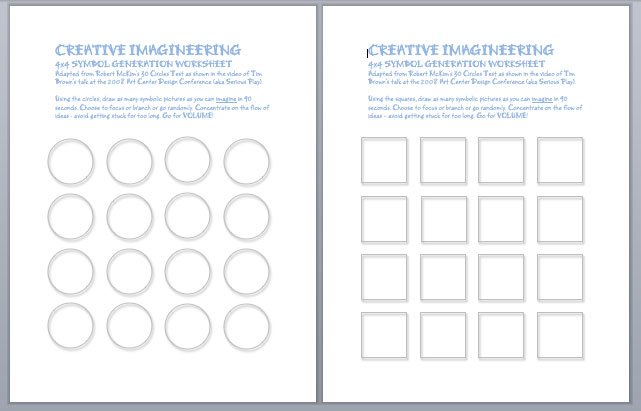If you’ve seen the video “Tales of Creativity and Play” of a talk by Tim Brown at the 2008 Art Center Design Conference (aka Sound Play) – that is available as a TED Talk at http://www.ted.com/talks/tim_brown_on_creativity_and_play.html, then you may remember the 30 Circles Test that the audience took part in. Following the 30 Circles Test, Brown remarks “And one of the things we tend to do as adults, again, is we edit things. We stop ourselves from doing things. We self-edit as we’re having ideas.” This is certainly something we can apply to youth creativity and in this post, I describe an early attempt to adapt this exercise for youth. But first, credit for the original test goes to Robert McKim, Professor Emeritus of Stanford’s Department of Mechanical Engineering who is credited with being “a pioneer in experiential psychology in design.”
The following is a set of screen captures from the Tim Brown Ted Talk video showing from left to right: the starting sheet of paper with circles pre-printed, an example of a completed sheet, and an audience member working on their sheet.
For the YCISL, I have created a sheet that has just 16 shapes (in a 4×4 matrix layout) instead of 30. On one side of the sheet is rubric with the matrix of circles. On the flip side is the same rubric with a matrix of squares. I also left relatively more space between the shapes to allow for extensions to the shape as opposed to only drawing within the shape. Making the shapes in MS Word, each shape is in a medium gray line with no fill and a drop shadow of the same color as the line – this to give a depth feel and encourage 3-D imagination.
Each side is titled at the top “Creative Imagineering” with the subtitle “4×4 Symbol Generation Worksheet.” I borrow the term “imagineering” to show that this activity exercises the imagination and requires some engineering to make it appear on the sheet of paper. The creative part is the participant choosing how to fill in the sheet – in sets or with randomness or with some other variation. I also include “Symbol” to indicate that a detailed and accurate representation is not necessary and rawness to the images is acceptable. Here is the rubric for the circle side of the sheet: “Using the circles, draw as many symbolic pictures as you can imagine in 90 seconds. Choose to focus or branch or go randomly. Concentrate on the flow of ideas – avoid getting stuck for too long. Go for VOLUME!”
Why the reduced number of shapes? It was partly because it was closer to any expectation of the number of shapes that a youth would be able to complete in the given time – thus greater potential satisfaction for the user in doing this exercise. This positions the exercise as a positive achievement and a result of flourishing imagination. The numerical total also somewhat coincides with the youth age range; we could say that a 16 year old or older, with their greater exposure to life, may be able to come up with 16 filled shapes. Then an approximate target of one shape per year of age could be posited to the group as a reference index. Lastly, the symmetrical layout allows for multiple directions in approaching and filling in the matrix with minimal bias – eg, inside out, outside in, diagonally, etc. You get it if you play Bingo.
This sheet may change as I observe the outcomes of exercises with this sheet.
Lastly, I let the students in my class today make paper airplanes with the used sheet of paper which plays into the exercise where students symbolically let their ideas “take flight.” More on that another time.


